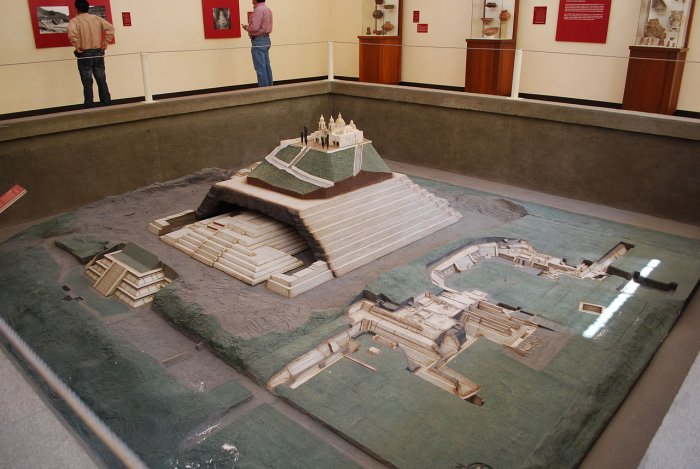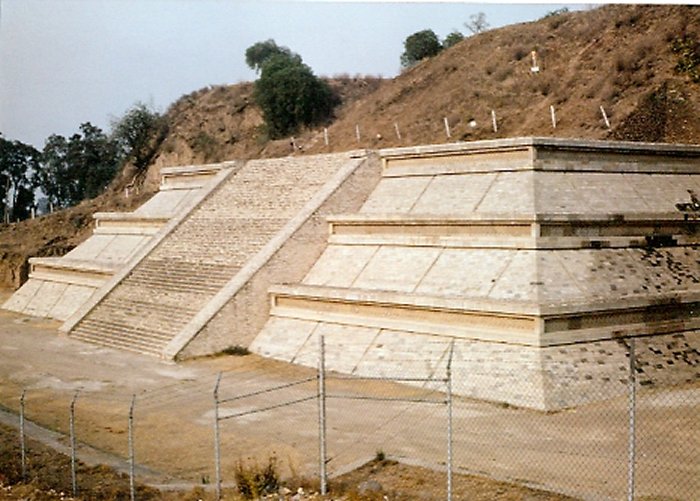Great Pyramid of Cholula Is The Largest In The World Today
A. Sutherland - AncientPages.com - Located in Cholula, Puebla, Mexico, the pyramid stands 55 meters (180 ft) above the surrounding plain, and in its final form, it measured 400 by 400 meters (1,300 by 1,300 ft).
Reconstruction of the Cholula pyramid. Image credit: AlejandroLinaresGarcia - CC BY-SA 4.0
According to the myth, the pyramid was built by a giant named Xelhua of adobe bricks after he escaped a flood in the neighboring Valley of Mexico.
Legend has it, Xelhua one of the seven giants of Aztec mythology who climbed the mountain of the rain god Tlaloc. Later, they built the Great Pyramid at Cholula. The Dominican monk wrote the following report:
"Before the great watershed occurred 4,800 years after the foundation of the world, the country of Anahuac was inhabited by giants, all of whom either died in the great watershed or were turned into fish, except for seven who fled to caves.
"When the waters receded, one of the Giants named Xelhua, nicknamed "The Architect," went to Cholula, where as a monument in honor of Tlaloc, who served as a shelter for him and his six brothers, he built an artificial hill in the form of a pyramid.
"He ordered the bricks to be made in the province of Tlalmanalco, at the foot of the Sierra Cecotl, and in order to deliver them to Cholula, he set up a government of men one by one who passed them from hand to hand. The gods noticed with anger the building, whose top was supposed to reach the clouds. Angered by Xelhuy's bold attempt, they threw fire at the pyramid.
"Many workers died. The work was abandoned and the monument was later dedicated to Quetzalcoatl..."
The Great Pyramid of Cholula (or in nahuatl Tlachihualtepetl), is a temple building in Cholula, in the state of Puebla in Mexico. Its name in nahuatl means "handmade mountain". It was dedicated to the god Quetzalcoatl. In time, Cholula became a mecca for pilgrims from all over Mexico, who flocked to the city to pay homage to the feathered serpent god.
Approximately one hundred years before Christ, the pyramid's construction began. Cholula, by this time, was already one of Mexico's largest cities, having been settled circa 1700 B.C. Various groups carried out the pyramid's structure, and affiliated temples over hundreds of years carried out the pyramid's construction.
Great Pyramid of Cholula, Puebla, Mexico. Image credit: Ernest Mettendorf - Public Domain
Upon the arrival of Cortés, Cholula was Mexico's second-largest city, with a population of up to 100,000 by some estimates. There is some disagreement about what happened next, but it appears that Cortés discovered the alliance between Cholula and Tenochtitlán; perhaps he became aware of a plot against the Spaniards, and he decided to make a pre-emptive attack. The temple was destroyed, and a church was built on the pyramid of Cholula, which the Spaniards believed was only a large hill.
The history of the pyramid is relatively unknown, From the 1930s until today, massive efforts have been made to excavate the pyramid. The pyramid consists of six superimposed structures, one for each ethnic group that dominated it.
The Great Pyramid of Cholula has a base four times the size of Pharaoh Khufu's Great Pyramid of Giza and is the most extensive pyramid base in the Americas.It is the largest pyramid found by archaeologists to date, with a base area four times larger than the Pyramid of Cheops in Egypt. The height of the pyramid is 66 m, and the width is 450 m. It is a very impressive structure.
The history of the pyramid is relatively unknown, but construction began around 300 f.Kr. It is dedicated to the Aztec Quetzalcoatl, and the area has been sacred from the beginning. Scientific explorations of the pyramid began in the 1930s.
Written by – A. Sutherland - AncientPages.com Senior Staff Writer
Updated on October 25, 2022
Copyright © AncientPages.com All rights reserved. This material may not be published, broadcast, rewritten or redistributed in whole or part without the express written permission of AncientPages.com
Expand for referencesMore From Ancient Pages
-
 How ‘Listening’ To Archaeological Sites Could Shed Light On The Past
Archaeology | Dec 8, 2023
How ‘Listening’ To Archaeological Sites Could Shed Light On The Past
Archaeology | Dec 8, 2023 -
 Ancient Germanic Ghost Warriors – Romans’ Greatest Military Defeat And Nightmare
Featured Stories | Feb 18, 2019
Ancient Germanic Ghost Warriors – Romans’ Greatest Military Defeat And Nightmare
Featured Stories | Feb 18, 2019 -
 Kiln Was Invented In Mesopotamia Around 6,000 B.C.
Ancient History Facts | Mar 7, 2018
Kiln Was Invented In Mesopotamia Around 6,000 B.C.
Ancient History Facts | Mar 7, 2018 -
 Riddle Of The Hanging Gardens Of Babylon – Highly Advanced Technologies – Part 2
Featured Stories | Jun 11, 2019
Riddle Of The Hanging Gardens Of Babylon – Highly Advanced Technologies – Part 2
Featured Stories | Jun 11, 2019 -
 Unexplained Visions Of Airmen – Controversial Investigation – Part 2
Featured Stories | Feb 9, 2020
Unexplained Visions Of Airmen – Controversial Investigation – Part 2
Featured Stories | Feb 9, 2020 -
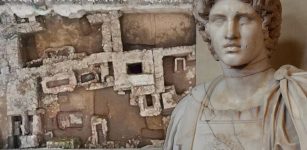 Amazing Photos Of Ancient Ruins Hidden Under Thessaloniki Metro Revealed By Archaeologists
Archaeology | Jan 9, 2023
Amazing Photos Of Ancient Ruins Hidden Under Thessaloniki Metro Revealed By Archaeologists
Archaeology | Jan 9, 2023 -
 Unique Page From Rare Illuminated Manuscript And Thousands Of Treasures Found Under The Floor Of Oxburgh Hall
Archaeology | Aug 18, 2020
Unique Page From Rare Illuminated Manuscript And Thousands Of Treasures Found Under The Floor Of Oxburgh Hall
Archaeology | Aug 18, 2020 -
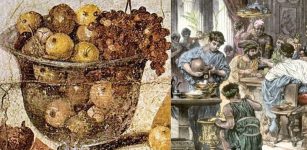 Citrus Was An Ancient Roman Symbol Of Status And Luxury
Ancient Symbols | Aug 23, 2017
Citrus Was An Ancient Roman Symbol Of Status And Luxury
Ancient Symbols | Aug 23, 2017 -
 8-Million-Year-Old Jaw May Offer Evidence Humans Evolved In Europe Instead Of Africa – Controversial Theory Suggests
Archaeology | Apr 24, 2019
8-Million-Year-Old Jaw May Offer Evidence Humans Evolved In Europe Instead Of Africa – Controversial Theory Suggests
Archaeology | Apr 24, 2019 -
 Mysterious Gold-Colored Chariot Washes Ashore In India – But Where Did It Come From?
News | May 12, 2022
Mysterious Gold-Colored Chariot Washes Ashore In India – But Where Did It Come From?
News | May 12, 2022 -
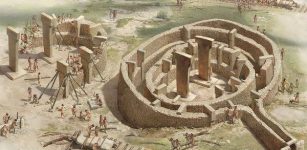 Mysterious Skull Cult At Göbekli Tepe – Ancestor Worship Or Trophies Of Dead Enemies?
Archaeology | Jul 25, 2017
Mysterious Skull Cult At Göbekli Tepe – Ancestor Worship Or Trophies Of Dead Enemies?
Archaeology | Jul 25, 2017 -
 Troublesome Ancient History Of Forks That Were Long A Shocking Sensation
Featured Stories | Nov 20, 2023
Troublesome Ancient History Of Forks That Were Long A Shocking Sensation
Featured Stories | Nov 20, 2023 -
 Our Understanding Of Human Prehistory And Societies Is Wrong – Scientists Say
Featured Stories | Nov 3, 2022
Our Understanding Of Human Prehistory And Societies Is Wrong – Scientists Say
Featured Stories | Nov 3, 2022 -
 3,300-Year-Old Bronze Figurine Of Canaanite God Unearthed At Lost Biblical City
Archaeology | Apr 12, 2020
3,300-Year-Old Bronze Figurine Of Canaanite God Unearthed At Lost Biblical City
Archaeology | Apr 12, 2020 -
 DNA Shows First Scandinavians Followed Two Distinct Migration Routes
Archaeology | Jan 11, 2018
DNA Shows First Scandinavians Followed Two Distinct Migration Routes
Archaeology | Jan 11, 2018 -
 Adad ‘Lord Of Abundance’- Mesopotamian Weather God Who Was Responsible For Fertility, Wealth And Oracles
Featured Stories | Mar 11, 2020
Adad ‘Lord Of Abundance’- Mesopotamian Weather God Who Was Responsible For Fertility, Wealth And Oracles
Featured Stories | Mar 11, 2020 -
 Suontaka Weapon Grave: New Light On Strong Female Leaders And Warriors Of Late Iron Age Finland
Archaeology | Jul 29, 2021
Suontaka Weapon Grave: New Light On Strong Female Leaders And Warriors Of Late Iron Age Finland
Archaeology | Jul 29, 2021 -
 Mysterious Denny – 90,000-Year-Old Child Whose Parents Were Two Different Human Species
Featured Stories | Jul 25, 2023
Mysterious Denny – 90,000-Year-Old Child Whose Parents Were Two Different Human Species
Featured Stories | Jul 25, 2023 -
 Is ‘Someone’ Regularly Altering The Course Of History? – Unexplained Events – Part 2
Featured Stories | Dec 3, 2020
Is ‘Someone’ Regularly Altering The Course Of History? – Unexplained Events – Part 2
Featured Stories | Dec 3, 2020 -
 Mount’s Bay, Lyonesse, Langarroc: Legendary Submerged Lands And Buried Towns Of Cornwall
Featured Stories | Apr 21, 2022
Mount’s Bay, Lyonesse, Langarroc: Legendary Submerged Lands And Buried Towns Of Cornwall
Featured Stories | Apr 21, 2022

